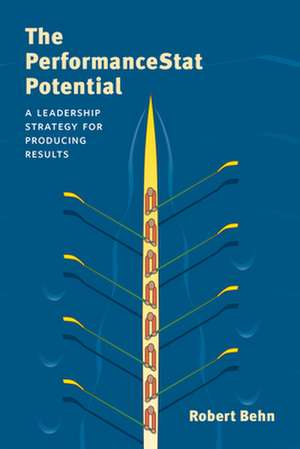The PerformanceStat Potential: A Leadership Strategy for Producing Results: Brookings / Ash Center Series, "Innovative Governance in the 21st Century"
Autor Robert D. Behnen Limba Engleză Paperback – 24 iun 2014
It started two decades ago with CompStat in the New York City Police Department, and quickly jumped to police agencies across the U.S. and other nations. It was adapted by Baltimore, which created CitiStat—the first application of this leadership strategy to an entire jurisdiction. Today, governments at all levels employ PerformanceStat: a focused effort by public executives to exploit the power of purpose and motivation, responsibility and discretion, data and meetings, analysis and learning, feedback and follow-up—all to improve government's performance.
Here, Harvard leadership and management guru Robert Behn analyzes the leadership behaviors at the core of PerformanceStat to identify how they work to produce results. He examines how the leaders of a variety of public organizations employ the strategy—the way the Los Angeles County Department of Public Social Services uses its DPSSTATS to promote economic independence, how the City of New Orleans uses its BlightStat to eradicate blight in city neighborhoods, and what the Federal Emergency Management Agency does with its FEMAStat to ensure that the lessons from each crisis response, recovery, and mitigation are applied in the future. How best to harness the strategy's full capacity? The PerformanceStat Potential explains all.
Here, Harvard leadership and management guru Robert Behn analyzes the leadership behaviors at the core of PerformanceStat to identify how they work to produce results. He examines how the leaders of a variety of public organizations employ the strategy—the way the Los Angeles County Department of Public Social Services uses its DPSSTATS to promote economic independence, how the City of New Orleans uses its BlightStat to eradicate blight in city neighborhoods, and what the Federal Emergency Management Agency does with its FEMAStat to ensure that the lessons from each crisis response, recovery, and mitigation are applied in the future. How best to harness the strategy's full capacity? The PerformanceStat Potential explains all.
Preț: 312.96 lei
Nou
Puncte Express: 469
Preț estimativ în valută:
59.89€ • 62.30$ • 49.44£
59.89€ • 62.30$ • 49.44£
Carte tipărită la comandă
Livrare economică 12-26 aprilie
Preluare comenzi: 021 569.72.76
Specificații
ISBN-13: 9780815725275
ISBN-10: 0815725272
Pagini: 413
Ilustrații: black & white illustrations, black & white tables, figures
Dimensiuni: 152 x 229 x 29 mm
Greutate: 0.59 kg
Editura: Brookings Institution Press
Colecția Brookings Institution Press/Ash Center
Seria Brookings / Ash Center Series, "Innovative Governance in the 21st Century"
ISBN-10: 0815725272
Pagini: 413
Ilustrații: black & white illustrations, black & white tables, figures
Dimensiuni: 152 x 229 x 29 mm
Greutate: 0.59 kg
Editura: Brookings Institution Press
Colecția Brookings Institution Press/Ash Center
Seria Brookings / Ash Center Series, "Innovative Governance in the 21st Century"
Notă biografică
Robert D. Behn is a lecturer at Harvard's Kennedy School of Government, where he is faculty chair of the executive education program "Driving Government Performance: Leadership Strategies that Produce Results." He is the author of Rethinking Democratic Accountability (Brookings) and writes the online monthly Bob Behn's Performance Leadership Report.
Descriere
A Brookings Institution Press and Ash Center for Democratic Governance and Innovation publication
It started two decades ago with CompStat in the New York City Police Department, and quickly jumped to police agencies across the U.S. and other nations. It was adapted by Baltimore, which created CitiStat—the first application of this leadership strategy to an entire jurisdiction. Today, governments at all levels employ PerformanceStat: a focused effort by public executives to exploit the power of purpose and motivation, responsibility and discretion, data and meetings, analysis and learning, feedback and follow-up—all to improve government's performance.
Here, Harvard leadership and management guru Robert Behn analyzes the leadership behaviors at the core of PerformanceStat to identify how they work to produce results. He examines how the leaders of a variety of public organizations employ the strategy—the way the Los Angeles County Department of Public Social Services uses its DPSSTATS to promote economic independence, how the City of New Orleans uses its BlightStat to eradicate blight in city neighborhoods, and what the Federal Emergency Management Agency does with its FEMAStat to ensure that the lessons from each crisis response, recovery, and mitigation are applied in the future. How best to harness the strategy's full capacity? The PerformanceStat Potential explains all.
It started two decades ago with CompStat in the New York City Police Department, and quickly jumped to police agencies across the U.S. and other nations. It was adapted by Baltimore, which created CitiStat—the first application of this leadership strategy to an entire jurisdiction. Today, governments at all levels employ PerformanceStat: a focused effort by public executives to exploit the power of purpose and motivation, responsibility and discretion, data and meetings, analysis and learning, feedback and follow-up—all to improve government's performance.
Here, Harvard leadership and management guru Robert Behn analyzes the leadership behaviors at the core of PerformanceStat to identify how they work to produce results. He examines how the leaders of a variety of public organizations employ the strategy—the way the Los Angeles County Department of Public Social Services uses its DPSSTATS to promote economic independence, how the City of New Orleans uses its BlightStat to eradicate blight in city neighborhoods, and what the Federal Emergency Management Agency does with its FEMAStat to ensure that the lessons from each crisis response, recovery, and mitigation are applied in the future. How best to harness the strategy's full capacity? The PerformanceStat Potential explains all.
























